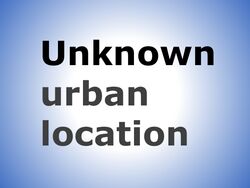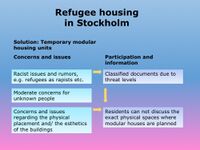LED 2016 Group H Landscape Democracy Challenge 3: Difference between revisions
| Line 61: | Line 61: | ||
== Reflection == | == Reflection == | ||
=== What are the major challenges for changing the situation? === | === What are the major challenges for changing the situation? === | ||
This landscape democracy challenge is complex as it ranges several different types of issues at the same time, from racist accusations to urban planning issues. Furthermore, planners are face with an acute situation where housing modules needs to be built very quickly, but with the normal planning laws and procedures. Adding to all this, the lack of information due to security concerns further adds to the challenge for changing the situation. | |||
=== What could be a starting point for democractically-based change? === | === What could be a starting point for democractically-based change? === | ||
Revision as of 14:40, 19 May 2016
Refugee housing in Stockholm – racism or valid concerns? A multidimensional democracy challenge
| Place name | Unknown and secret temporary places | |
| Location | Stockholm | |
| Country | Sweden | |
| Author(s) | Emil Buzzi | |

| ||
Rationale: Why have you chosen this case for the landscape and democracy seminar?
In a fairly large city as Stockholm, landscape democracy challenges are up for discussion every day. The urban landscape is constantly challenged in a myriad of ways. Recently however, a new complex challenge has emerged. With a high number of arriving refugees in Sweden during the fall of 2015, the government has asked municipalities to provide housing for those seeking asylum. Municipalities in the county of Stockholm are therefore planning for temporary housing modules to be constructed around the city. This has in many municipalities resulted in protests from local residents.
This landscape democracy challenge is complex as it involves both social issues concerning refugees in general to the physical built landscapes in the neighbourhoods where temporary houses are planned. Municipalities and planners have to navigate both purely racist protests when a new project is advertised and also deal with the concerns over the urban environment when they arrange information and participation efforts.
The two different sides of this challenge, the urban built environment when constructing temporary housing units and the concerns over refugees in general, has to be dealt with by planners. However, these issues are in reality hard to separate, thus resulting in a complex landscape democracy challenge for municipalities and planners.
Representation of your observations
A multidimensional democracy challenge
Modular housing in Stockholm-municipalities
As a consequence of the influx of refugees during 2015 to Sweden, municipalities in the county of Stockholm are required to accommodate housing for refugees that can not find their own housing. However, important to note is that a majority of refugees moving to Stockholm municipality arrange their housing themselves [1]. During 2016, the municipality of Stockholm needs to arrange housing for 2800 refugees as well as housing for unaccompanied refugee children that during late 2015 was around 2000 in the municipality. The municipality of Stockholm is thus under pressure to quickly construct temporary housing modules in different locations around the city [2][3]. Other municipalities in the county of Stockholm are also required to build provide housing and has also turned to the solution with temporary housing modules. One example is the municipality of Botkyrka that are building 44 modular housing units. The municipality of Botkyrka held an information-meeting for residents in the area where the houses are planned and the local newspaper described people attending the meeting as upset but relatively calm and reasonable. In Nacka, another Stockholm municipality, residents are accusing the not-yet-known-refugees to be potential rapists and murderers. Here, some residents are in favour of having a criminal biker-gang rather than housing for refugees [4].
Furthermore, as municipalities are dealing with issues of social concerns from local residents, they are in parallel working with the formal information and participation process when building and obtaining all permits for the temporary housing units. The municipality of Stockholm is going through the normal procedure that is required for any temporary housing projects, but have made the documents secret due to the threat-level towards this kind of housing [1]. During the fall of 2015 and the beginning of 2016, planned housing for refugees around Sweden has been burned down after the locations of the planned projects has been publicly known [5][6]. Because of this, most building projects for refugees are made with secrecy.
Social concerns or urban planning? Complexity and tension
As the introduction above to the situation of temporary housing projects in different Stockholm municipalities suggests, the planning for these temporary modular houses is complex. The complexity is built up by several aspects. First is the acute need for these housing units with the high number of refugees from the war in Syria. Secondly, the sometimes very strong opposition by local residents requires special attention by planners. Thirdly, despite the first two issues, planners need to conduct all the normal procedures associated with urban planning development. This means that planners and municipalities are dealing with both social/cultural concerns and urban planning issues at the same time.
When information meetings and participatory are organised, planners thus needs to deal with everything from purely racist views towards refugees, to valid moderate concerns, to purely urban planning concerns, e.g. the location of houses and preservations of parks and playgrounds.
Adding to all this, open-meetings arranged for local residents has in several cases been visited by violent nazi-organisations who have raised racist comments by arguing that women and children are in danger if refugees are allowed to reside in the temporary housing that is planned in the area. These nazi-organisations has during meetings been both argued against and backed by local residents during meetings [7][8][9]. This puts planners and municipalities in a very difficult and challenging situation.
Dealing with this Landscape Democracy Challenge
The description of this Landscape Democracy Challenge is far from away from traditional urban planning and development discussions. Here, strong opinions and concerns regarding refugees are mixed with issues of urban planning. For municipalities and planners responsible for the planning of temporary modular housing for refugees, they are challenged with complexity interaction with the public. Planners need to both interact in their normal sphere, discussing the position of the modules and the places they need to use for building, but also far outside their normal zone of work, dealing with concerns and strong acquisitions towards the refugees that are planned to move in to the temporary modules. Furthermore, as these housing projects are under threat, municipalities have in some cases decided to make the document secret, thus adding another challenge to the discussion as residents can not fully discuss the places where the houses are planned as they only give an indication of the area.
Lastly, when approaching this kind of complicated and tense landscape democracy challenge, an important question to ask if this type of contested issues can be resolved at all. When looking at the very hard and often racist accusations towards refugees and strong oppositions to the project, it seems that a solution is very far away. One could argue that information meetings and participation methods is not meant to be use for solving these kinds of problems, rather to create an arena for discussion. The famous philosopher Chantal Mouffe (2007, 3) have this later view on conflict and argues that: “[…] the public space is the battleground where different hegemonic projects are confronted, whiteout any possibility of finial reconciliation”. Having this view when approaching complicated landscape democracy challenges, one could maybe use another approach where information and participation methods are used to create an arena where people listen to each other, while not trying to push one agenda or solution. However, as described above, this particular case is tense and complicated and there is a pressing need to find some way past the aggressive stage of discussion, whiteout that, the prospects for this landscape challenge does not look good.
Reflection
What are the major challenges for changing the situation?
This landscape democracy challenge is complex as it ranges several different types of issues at the same time, from racist accusations to urban planning issues. Furthermore, planners are face with an acute situation where housing modules needs to be built very quickly, but with the normal planning laws and procedures. Adding to all this, the lack of information due to security concerns further adds to the challenge for changing the situation.
What could be a starting point for democractically-based change?
- Please add approx. 150 words in essay style
References
[1] http://www.stockholm.se/FamiljOmsorg/Socialt-och-ekonomiskt-stod/Flyktingmottagande/Boende/ ∗
[5] http://www.svd.se/samordningen-avbruten--men-branderna-fortsatter ∗∗
[6] http://www.gp.se/nyheter/sverige/%C3%B6ver-40-asylboenden-har-brunnit-1.179215 ∗∗
[8] http://www.expressen.se/nyheter/haninge-kommuns-mote-slutade-i-kaos/ ∗∗
[9] http://www.dn.se/sthlm/mote-om-ensamkommande-flyktingar-sparade-ur/ ∗∗
Comments regarding the non-english references to this work:
∗ This is the official website of the municipality of Stockholm with information regarding temporary housing units for refugees
∗∗ All media links are from well-known and established local and national press
About categories: You can add more categories with this tag: "", add your categories
